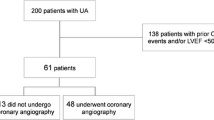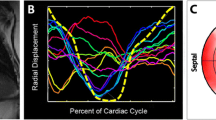Abstract
To investigate if the 12-lead resting electrocardiogram (ECG) is a predictor of left ventricular (LV) functional recovery after revascularization of chronic total coronary artery occlusions (CTO). Revascularization was performed in 58 CTO patients who had impaired regional wall motion. The 12-lead resting ECG was used to evaluate Q-wave, QT dispersion, and other parameters. Pre- and postoperative LV regional wall motions were evaluated by real-time three-dimensional echocardiography (RT-3DE). In patients with non-Q-wave, the wall motion score index (WMSI) was dropped from 1.56 ± 0.31 to 1.12 ± 0.21 (P < 0.05), while there was no significant changes (1.73 ± 0.12 and 1.59 ± 0.23, P > 0.05) for WMSI in patients with Q-wave. Preoperative non-Q-wave at baseline was predicted recovery with 88 % sensitivity and 68 % specificity. Positive predictive value for recovery was 67 % in patients with non-Q-wave. The presence of Q-wave can predict non-recovery of the regional wall motion with 68 % sensitivity and 88 % specificity. For CTO patients treated by revascularization, recovery can be predicted reliably through the analysis of pathological Q-wave on the 12-lead resting ECG.



Similar content being viewed by others
References
Nie, S. P., & Ma, C. S. (2005). Coronary artery disease treated by revascularization—Evidence-based 2004 (1). Chinese Journal of Cardiovascular Review, 3, 7.
Nie, S. P., & Ma, C. S. (2005). Coronary artery disease treated by revascularization—Evidence-based 2004 (2). Chinese Journal of Cardiovascular Review, 3, 83.
Shi, X. B., & Hu, D. Y. (2003). The 14th Great Wall International Cardiology Conference Synopsis. Chinese Journal of Cardiovascular Review, 1, 83.
Ouyang, P., He, S. H., Chen, W. K., et al. (2001). Application of ChoICE PT guidewire for recanalization of totally occluded coronary arteries. Journal of First Military Medical University, 21, 770–772.
Alpert, J. S., Thygesen, K., Antman, E., & Bassand, J. P. (2000). Myocardial infarction redefined—A consensus document of The Joint European Society of Cardiology/American College of Cardiology Committee for the redefinition of myocardial infarction. European Heart Journal, 21, 1502–1513.
Selvester, R. H., Wagner, G. S., & Hindman, N. B. (1985). The Selvester QRS scoring system for estimating myocardial infarct size. The development and application of the system. Archives of Internal Medicine, 145, 1877–1881.
Schiller, N. B., Shah, P. M., Crawford, M., et al. (1989). Recommendations for quantitation of the left ventricle by two-dimensional echocardiography. American Society of Echocardiography Committee on Standards, Subcommittee on Quantitation of Two-Dimensional Echocardiograms. Journal of the American Society of Echocardiography, 2, 358–367.
Haque, T., Furukawa, T., Takahashi, M., et al. (1995). Identification of hibernating myocardium by dobutamine stress echocardiography: Comparison with thallium-201 reinjection imaging. American Heart Journal, 130, 553–563.
Qureshi, U., Nagueh, S. F., Afridi, I., et al. (1997). Dobutamine echocardiography and quantitative rest-redistribution 201Tl tomography in myocardial hibernation. Relation of contractile reserve to 201Tl uptake and comparative prediction of recovery of function. Circulation, 95, 626–635.
Schinkel, A. F., Bax, J. J., Boersma, E., et al. (2002). Assessment of residual myocardial viability in regions with chronic electrocardiographic Q-wave infarction. American Heart Journal, 144, 865–869.
Baer, F. M., Voth, E., Deutsch, H. J., et al. (1996). Predictive value of low dose dobutamine transesophageal echocardiography and fluorine-18 fluorodeoxyglucose positron emission tomography for recovery of regional left ventricular function after successful revascularization. Journal of the American College of Cardiology, 28, 60–69.
Schneider, C. A., Voth, E., Baer, F. M., et al. (1997). QT dispersion is determined by the extent of viable myocardium in patients with chronic Q-wave myocardial infarction. Circulation, 96, 3913–3920.
Mobilia, G., Zanco, P., Desideri, A., et al. (1998). T wave normalization in infarct-related electrocardiographic leads during exercise testing for detection of residual viability: Comparison with positron emission tomography. Journal of the American College of Cardiology, 32, 75–82.
Palmeri, S. T., Harrison, D. G., Cobb, F. R., et al. (1982). A QRS scoring system for assessing left ventricular function after myocardial infarction. New England Journal of Medicine, 306, 4–9.
Selvester, R. H., Wagner, G. S., & Hindman, N. B. (1985). The Selvester QRS scoring system for estimating myocardial infarct size. The development and application of the system. Archives of Internal Medicine, 145, 1877–1881.
Desideri, A., Zanco, P., Bertella, M., et al. (2002). Comparison of positron emission tomography with the resting electrocardiogram for assessing viable myocardium in chronic ischemic cardiomyopathy involving the anterior left ventricular wall. American Journal of Cardiology, 90, 878–882.
Schinkel, A. F., Bax, J. J., Elhendy, A., et al. (2002). Assessment of viable tissue in Q-wave regions by metabolic imaging using single-photon emission computed tomography in ischemic cardiomyopathy. American Journal of Cardiology, 89, 1171–1175.
Schinkel, A. F., Bax, J. J., Geleijnse, M. L., et al. (2003). Noninvasive evaluation of ischaemic heart disease: Myocardial perfusion imaging or stress echocardiography? European Heart Journal, 24, 789–800.
Vanoverschelde, J. L., Wijns, W., Depré, C., et al. (1993). Mechanisms of chronic regional postischemic dysfunction in humans. New insights from the study of noninfarcted collateral-dependent myocardium. Circulation, 87, 1513–1523.
Shivalkar, B., Maes, A., Borgers, M., et al. (1996). Only hibernating myocardium invariably shows early recovery after coronary revascularization. Circulation, 94, 308–315.
Pagano, D., Townend, J. N., Parums, D. V., et al. (2000). Hibernating myocardium: Morphological correlates of inotropic stimulation and glucose uptake. Heart, 83, 456–461.
Author information
Authors and Affiliations
Corresponding author
Rights and permissions
About this article
Cite this article
Yue, W., Wang, G., Zhang, X. et al. Electrocardiogram for Predicting Cardiac Functional Recovery. Cell Biochem Biophys 70, 87–91 (2014). https://doi.org/10.1007/s12013-014-9862-2
Published:
Issue Date:
DOI: https://doi.org/10.1007/s12013-014-9862-2




